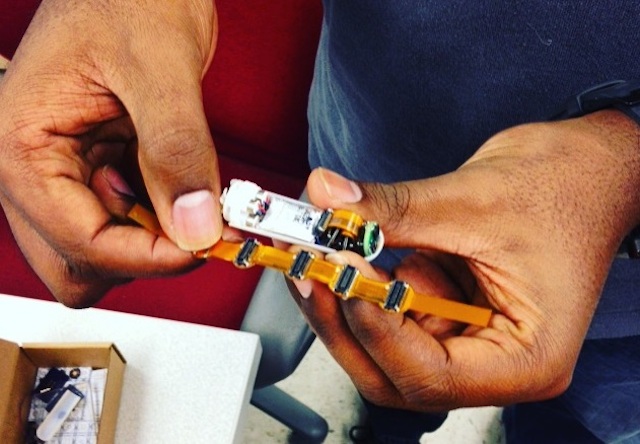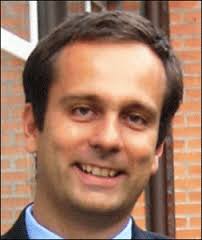Vanderbilt Open Sources Hardware and Software for Medical Capsule Robots
 Addisu Taddese, National Science Foundation Graduate Fellowship recipient, holds a medical capsule robot. (Heidi Hall/Vanderbilt University)Researchers around the globe who want to customize medical capsule robots won’t have to start from scratch – a team from Vanderbilt University School of Engineering did the preliminary work for them and is ready to share. Through a website and a paper revealed at a pair of Institute of Electrical and Electronics Engineers (IEEE) conferences, Assistant Professor of Mechanical Engineering Pietro Valdastri, Associate Professor of Computer Engineering Akos Ledeczi and their team made the capsule hardware and software open-source.
Addisu Taddese, National Science Foundation Graduate Fellowship recipient, holds a medical capsule robot. (Heidi Hall/Vanderbilt University)Researchers around the globe who want to customize medical capsule robots won’t have to start from scratch – a team from Vanderbilt University School of Engineering did the preliminary work for them and is ready to share. Through a website and a paper revealed at a pair of Institute of Electrical and Electronics Engineers (IEEE) conferences, Assistant Professor of Mechanical Engineering Pietro Valdastri, Associate Professor of Computer Engineering Akos Ledeczi and their team made the capsule hardware and software open-source.
The paper, titled “Systematic Design of Medical Capsule Robots,” ran in a special issue of IEEE Design & Test magazine dedicated to cyber-physical systems for medical applications. Within years, Vanderbilt’s capsule robots, made small enough to be swallowed, could be used for preventative screenings and to diagnose and treat a number of internal diseases.
“We’ve done custom capsule design – one for the colon, one for the stomach, another one with a surgical clip to stop bleeding – but we saw we were basically reusing the same components,” said Valdastri, director of Vanderbilt’s Science and Technology of Robotics in Medicine (STORM) Lab. “Like it is with Lego bricks, you can reassemble them for different functions. We wanted to provide the people working in this field with their own Lego bricks for their own capsules.”
 Pietro ValdastriNow research groups with hypotheses about how to use the capsules won’t have to redesign boards and interfaces from scratch, which means they can get to the prototyping stage faster. Medical capsule robots differ from the PillCam, put on the market in 2001, because they can be manipulated to perform internal tasks rather than just passing through the body and recording video.
Pietro ValdastriNow research groups with hypotheses about how to use the capsules won’t have to redesign boards and interfaces from scratch, which means they can get to the prototyping stage faster. Medical capsule robots differ from the PillCam, put on the market in 2001, because they can be manipulated to perform internal tasks rather than just passing through the body and recording video.
The paper explains the hardware modules available, which handle computation, wireless communication, power, sensing and actuation. Each is designed to interface easily with new modules contributed from other research groups. On the software side, Vanderbilt engineers used TinyOS — a free, open-source, flexible operating system — to develop reusable components. Ledeczi, senior research scientist at Vanderbilt’s Institute for Software Integrated Systems, said a medical capsule robot is the ideal example of a cyber-physical system.
It must work inside the challenging physical environment of the human body, sense its environment and move through it effectively, and then complete tasks such as release a drug, take a tissue sample or deploy a clamp. Finally, it must constantly communicate with a base station through the entire process. “Our focus is the design environment, not the software per se, with the goal of easing the learning curve for new researchers and engineers who start in this field,” Ledeczi said. “Designing a capsule from scratch requires deep hardware, software and domain expertise.”
 Akos LedecziBy providing a hardware and software component library and the tools to make their composition easy, Vanderbilt opens up the field of medical capsule robots to engineers and scientists who have great ideas but aren’t hardware or software experts, plus makes development costs far more affordable, he said.
Akos LedecziBy providing a hardware and software component library and the tools to make their composition easy, Vanderbilt opens up the field of medical capsule robots to engineers and scientists who have great ideas but aren’t hardware or software experts, plus makes development costs far more affordable, he said.
Already, the Royal Infirmary of Edinburg in Scotland, Chinese University of Hong Kong, Chonnam National University in South Korea and a number of other institutions have demonstrated an interest in using the technology.
The team presented its work at the IEEE/RSJ International Conference on Intelligent Robots and Systems in Hamburg, Germany, in September and the IEEE International Conference on Robotics and Automation in Seattle, Washington, in May.
Other team members are: Marco Beccani, who graduated with a Ph.D. in mechanical engineering from Vanderbilt in July and is now post-doctoral fellow at University of Pennsylvania; STORM Lab postdoctoral scholar Ekawahyu Susilo; Institute for Software Integrated Systems research assistant/graduate student Hakan Tunc; Institute for Software Integrated Systems research scientist Peter Volgyesi; and Addisu Taddese, National Science Foundation Graduate Fellowship recipient and a graduate student affiliated with STORM Lab and the Institute for Software Integrated Systems.
Their work was supported by the National Science Foundation through the Cyber-Physical System Program (Award #CNS-1239355), Valdastri’s CAREER Award (IIS-1453129), and the Graduate Research Fellowship Program (Award #1445197).
Contact
Heidi Hall, (615) 322-6614
Heidi.Hall@Vanderbilt.edu
On Twitter @VUEngineering
- Tags:
- accelerating prototyping stage
- Addisu Taddese
- Akos Ledeczi
- Chinese University of Hong Kong
- Chonnam National University in South Korea
- cyber-physical systems for medical applications
- diagnose internal diseases Ekawahyu Susilo
- Hakan Tunc
- hardware modules
- IEEE Design & Test magazine
- IEEE International Conference on Robotics and Automation
- IEEE/RSJ International Conference on Intelligent Robots and Systems
- Institute of Electrical and Electronics Engineers (IEEE)
- Marco Beccani
- medical capsule robot. National Science Foundation
- Open Hardware
- open source
- open source operating system
- Peter Volgyesi
- Pietro Valdastri
- PillCam
- preventative screenings
- reusing components
- Royal Infirmary of Edinburg in Scotland
- Science and Technology of Robotics in Medicine (STORM) Lab
- surgical clip to stop bleeding
- TinyOS
- treat internal diseases
- Vanderbilt University School of Engineering
- Vanderbilt’s Institute for Software Integrated Systems
- Login to post comments